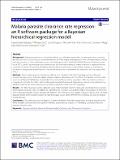Malaria parasite clearance rate regression: an R software package for a Bayesian hierarchical regression model
Author(s)
Sharifi-Malvajerdi, Saeed; Zhu, Feiyu; Fay, Michael P; Fairhurst, Rick M; Flegg, Jennifer A; Stepniewska, Kasia; Small, Dylan S; Fay, Michael P.; Fairhurst, Rick M.; Flegg, Jennifer A.; Small, Dylan S.; Fogarty, Colin B; ... Show more Show less
Download12936_2018_Article_2631.pdf (2.294Mb)
PUBLISHER_CC
Publisher with Creative Commons License
Creative Commons Attribution
Terms of use
Metadata
Show full item recordAbstract
Background
Emerging resistance to anti-malarial drugs has led malaria researchers to investigate what covariates (parasite and host factors) are associated with resistance. In this regard, investigation of how covariates impact malaria parasites clearance is often performed using a two-stage approach in which the WWARN Parasite Clearance Estimator or PCE is used to estimate parasite clearance rates and then the estimated parasite clearance is regressed on the covariates. However, the recently developed Bayesian Clearance Estimator instead leads to more accurate results for hierarchial regression modelling which motivated the authors to implement the method as an R package, called “bhrcr”.
Methods
Given malaria parasite clearance profiles of a set of patients, the “bhrcr” package performs Bayesian hierarchical regression to estimate malaria parasite clearance rates along with the effect of covariates on them in the presence of “lag” and “tail” phases. In particular, the model performs a linear regression of the log clearance rates on covariates to estimate the effects within a Bayesian hierarchical framework. All posterior inferences are obtained by a “Markov Chain Monte Carlo” based sampling scheme which forms the core of the package.
Results
The “bhrcr” package can be utilized to study malaria parasite clearance data, and specifically, how covariates affect parasite clearance rates. In addition to estimating the clearance rates and the impact of covariates on them, the “bhrcr” package provides tools to calculate the WWARN PCE estimates of the parasite clearance rates as well. The fitted Bayesian model to the clearance profile of each individual, as well as the WWARN PCE estimates, can also be plotted by this package.
Conclusions
This paper explains the Bayesian Clearance Estimator for malaria researchers including describing the freely available software, thus making these methods accessible and practical for modelling covariates’ effects on parasite clearance rates.
Date issued
2019-01Department
Sloan School of ManagementJournal
Malaria Journal
Publisher
BioMed Central
Citation
Sharifi-Malvajerdi, Saeed et al. "Malaria parasite clearance rate regression: an R software package for a Bayesian hierarchical regression model." Malaria Journal 18 (January 2019): 4 © 2019 The Author(s)
Version: Final published version
ISSN
1475-2875